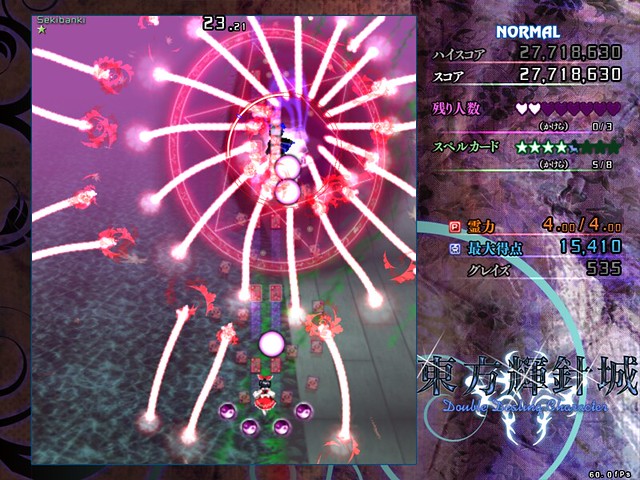Posts from ‘Doujin’ Category
Doujin A-Go-Go: Comiket 88 and BitSummit 2015
By: Derek Yu
On: August 13th, 2015
This year’s Comiket, Japan’s premiere festival for self-published works, is starting tomorrow (August 14-16). As in previous years, the doujin shmup developer Edelweiss has put together a long compilation video that combines trailers for a number of games that will be available at the festival. Links to each of the games featured in the video are available here on Edelweiss’s website.
Coinciding with Comiket is a doujin games sale on Steam, including big discounts on La Mulana and a number of highly-regarded shoot ’em ups like Crimzon Clover and Kamui. Or if participating in an underwater deathmatch as a laser-shooting barnacle is more your thing, check out NEO AQUARIUM – The King of Crustaceans.
Also, earlier this summer was the third BitSummit, a Japanese indie games conference that takes place in Kyoto. Unlike Comiket, which features all kinds of amateur media and fan works, BitSummit is focused entirely on promoting the indie game community in Japan and helping their game developers share knowledge, network, and get noticed, much in the way that the Independent Games Summit and Festival do for devs that attend GDC. So far it seems to be a great success, with plenty of press coverage and new partnerships, including one with the Indie MEGABOOTH. This Verge article has a nice round-up of some of the games on the show floor.
It’s great to see the Japanese indie and doujin game communities blossoming and expanding their reach internationally. These days it’s actually quite easy to find and purchase Japanese indie titles through Steam and Playism, which was unthinkable only a few years ago during the peak of Cave Story fever. I can only imagine that this trend will keep blowing up in the years to come.
Double Dealing Character (Touhou 14) on Playism
By: Derek Yu
On: June 14th, 2015
The fourteenth game in the popular Touhou danmaku shoot ’em up series, Double Dealing Character, is also the first one to receive an official release outside of Japan, through Playism, an indie game distribution platform that focuses on Japanese indie titles. This is also the first Touhou game to get released as a downloadable title – the series is usually released on CD at Tokyo’s Comic Market. “Comiket”, as it’s more commonly known, is the world’s largest convention for doujin works.
The scoring system in DDC is based around the “POC” (point of collection), an invisible line near the top of the screen that appears in all of the modern Touhou games. By crossing this line, any point items dropped by enemies will be sucked in by the player. In DDC, this leads to higher scores as well as bonus items that can grant bombs or extends.
The simple, “back to basics” scoring system and digital download make DDC a decent enough introduction to the Touhou series, although it should be noted that this is not a localized port, just a convenient way to purchase and play the original Japanese game that was released at Comiket in 2013. However, this wiki explains the basic mechanics and screen layout. A three-level demo is also available to try out before purchasing.
Comiket 86: Preview Video
By: Derek Yu
On: August 12th, 2014
This is a video that mashes up quite a few trailers for doujin games that will be available at this year’s Comiket (Comic Market), a Japanese self-published comic book festival (and the largest in the world, with over half a million attendees last year). Edelweiss, the doujin shmup developer behind Ether Vapor and Astebreed, has been putting these videos together for the past few years. The festival is taking place this weekend on August 15-17.
Links to each of the games featured in the video are available here on Edelweiss’s website.
Crimzon Clover WORLD IGNITION
By: Derek Yu
On: June 29th, 2014
In what is hopefully part of a continuing trend, Crimzon Clover has been released on Steam as Crimzon Clover WORLD IGNITION, giving PC players around the globe easy access to one of the best doujin bullet hell shoot ’em ups. Originally released in 2011 at Comiket 79, the game was largely created by one person: Yotsubane, also known as the Cave superplayer Clover-TAC. From there, its popularity led to an enhanced edition on Taito’s NESiCAxLive, a digital download platform for Japanese arcades, followed by this recent port to Steam.
In Crimzon Clover you have two main attacks, a rapid-fire shot that fires straight ahead and a lock-on shot that creates a quickly-expanding circle around your ship, targeting every enemy it touches for a powerful homing laser attack. On top of that, there is a third button, called the Break Button, which does different things depending on the status of the Break Gauge. Destroying enemies fills up the gauge and if it’s filled above a certain threshold, hitting the button fires a bomb that clears bullets. If the gauge is completely full, however, you enter a “Break Mode” where your firepower and scoring ability are increased dramatically for a limited amount of time. During Break Mode it’s also possible to enter a “Double Break Mode” that ups everything (including enemy ferocity) even further, turning the screen into a page from a Magic Eye book.
Fans of Japanese shoot ’em ups already know about Crimzon Clover and this port, but it’s also a great introductory shmup that is polished and offers a lot of modern conveniences like tutorials and novice modes to help new players get accustomed to the brutal level of difficulty. Plus, the relatively simple, memorization-free scoring system and sheer destructive firepower at hand should be enjoyable for veterans and newcomers alike. If I have one complaint, it’s that the graphics veer toward the garish and it is often hard to find your ship’s tiny yellow hitbox amidst the sludge of bullets, stars, and machinery. But it could be argued that this eye-bleeding quality is part of the game’s appeal. In any case, at $10 on Steam, it’s never been easier to play this previously obscure jewel of the genre.
Jelly no Puzzle
By: ithamore
On: February 23rd, 2013
Jelly no Puzzle is the latest difficult puzzle game from Qrostar. It shares some similarities with his earlier Hanano Puzzle but has enough changes in the gameplay to make it a new challenge. Mainly, the jelly blocks push each other instead of being switchable.
Qrostar is still making tweaks to the game before finalizing it, but I found the current version very playable. The latest improvement-in-progress should help to compensate for colorblindness through adjustments made to the color values. So, if you have something to report or a comment to share with him, you can head over to his diary to post it. That’s also were you can find a link to download alternate versions of levels 38, 39 and 40 that were replaced during development.
Comiket 82: Preview Video
By: Derek Yu
On: August 7th, 2012
This is a video that mashes up quite a few trailers for doujin games that will be available at this year’s Comiket (Comic Market), a Japanese self-published comic book festival (and the largest in the world, with half a million attendees last year). The video was put together by Edelweiss, a doujin game developer that created Ether Vapor and is attending Comiket 82 with a new shoot ’em up called Astebreed. The festival is taking place this weekend on August 10-12.
Links to each of the games featured in the video are available here on Edelweiss’s website.
(Source: Elixir)
Hellsinker
By: Derek Yu
On: June 15th, 2012
Despite (because of?) being a pretty dense and esoteric doujin bullet hell shoot ’em up, Hellsinker has enjoyed a cult success over the years. But now that an English translation patch has been finished, perhaps more people can enjoy its unique flavor of shooting. Thanks to Noah! from the forums for posting enthusiastically about it a few months ago.
Like most shoot ’em ups, the goal of the game is to advance through the stages and earn a high score (called “spirit” in HS). However, Hellsinker also has a unique meter called “terra” that can deplete to send you to the Shrine of Farewell, a special boss rush level that resets your spirit counter but can end up doubling it if you’re good enough. There are many other quirks to the game, and the numerous ship types ensure that there’s a lot to understand here, whether you’re playing it in your native language or not.
Beyond that, if you’re interested in learning more about Hellsinker, you’re probably best off exploring it yourself or looking through the various guides that I’ve posted below along with the download/purchase links:
Shadow Break
By: Derek Yu
On: June 6th, 2012
Shadow Break (direct download) is fun freeware action game with a unique take on Breakout – ninjas and other opponents are trapped in the blocks and can be released to the ground to slay with your sword. Aside from slashing and jumping, your character also has an invincible dash and ninjitsu techniques that let you, for example, freeze the ball in place. After defeating all the enemies in a level, the remaining blocks are converted to coins.
Quite a polished little Japanese indie title. I like the variety in the enemies and bosses.
(Source: Free Indie Games)
TIGdb: Entry for Shadow Break
Ao Oni
By: Derek Yu
On: March 17th, 2012

A group of teenagers enter an abandoned mansion on the outskirts of town to see if it’s haunted… an unimaginative set up for a horror tale, but thankfully it’s not indicative of the rest of the game. Released in 2009 by the Japanese developer noprops, Ao Oni has since gained a cult reputation for its inventive scares and challenging puzzles. Given that it’s made in RPGMaker XP, the game’s not Amnesia-levels of scary, but it squeezes a lot out of the aging engine to provide a suitably creepy backdrop for the puzzle-solving.
Everything you need to play Ao Oni is available at its homepage, including the RPGMaker XP runtime. There are Japanese, English, and Italian language editions of the game – just download your preferred translation, unzip, and run (after installing the runtime, of course). Keep in mind that different versions of Ao Oni vary greatly in terms of plot and design… older versions are available from other websites if you’re interested (but beware of spoilers).
TIGdb: Entry for Ao Oni
Hydra Castle Labyrinth
By: Derek Yu
On: January 10th, 2012
Hydra Castle Labyrinth is a nice Galious-like by E. Hashimoto (aka “Buster”), who also made Akuji the Demon. The game was released last year and has been fully translated into English by Gary the Krampus.






